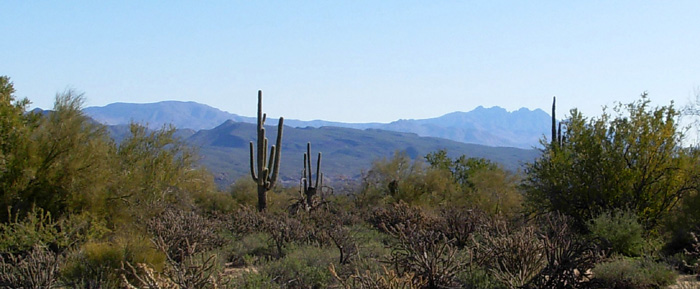Just how big is the Fort Hood Army post??
Consider these stats and facts gathered from the installation's
own
website, Wikipedia, and information we gathered on
post:
- It covers 340 square miles (217,337 acres) in Bell County, TX,
midway between Waco and Austin. If you look on a map, the colored area
appears about as large as Houston (the city, not all the suburbs).
- It is the only post in the United States capable of stationing and
training two Armored Divisions: the 1st Cavalry Division and 4th
Infantry Division. There are an additional twelve units on post,
including an army medical center and hospital, military police, air
combat, and intelligence brigades.
- From 41,000 to 65,000 soldiers have been assigned to Fort Hood in
recent years, approximately one out of every ten active duty soldiers
(the numbers are always changing). Peak troop population at then-Camp
Hood was 95,000 in 1943-4 during WWII.
- 70,000 family members live on post; others live off-post.
- A lot of those family members are children. There are six
elementary schools and two middle schools on post (no high schools --
teens attend schools in Belton or Killeen).
- Over 12,000 civilian employees and contractors work on Fort Hood.
- Enough people live and work at Fort Hood to support two large PXs
(Post Exchanges, like department/electronics stores) and two
commissaries (grocery stores), both of which are tax-free; a
gazillion banks (it seemed); several gas stations;
numerous restaurants, snack bars, lounges, and food courts;
nine fitness centers; ten swimming pools; lots of other
sports and fitness programs and outdoor recreational activities;
six child development centers and four youth centers; nine
chapels; two museums; a library, theatre, and veterinary clinic;
and many other organizations and services for troops and their families
-- just like a small city!
- The installation has a huge financial impact on the local and
state economy, to the tune of 10.9 billion-with-a-B dollars in
2007.
So, yes, we found lots to do there.
[Note: since I didn't take any photos on post, I'll
include more here from Belton Lake; that's part of Fort
Hood, too.]
GAINING ENTRANCE TO FORT HOOD
In the
last entry, I wrote about
spending the last eleven days camping at
BLORA,
the scenic Belton Lake Outdoor Recreation Area. This is one of
only a few sections of the massive Fort Hood Army Post that is
open to the public since the terrorist attacks on September 11,
2001. Visitors may enter the post for various special events,
like a huge fireworks display on July 4, and to see the two
museums, eat at Club Hood, and visit a few other places.
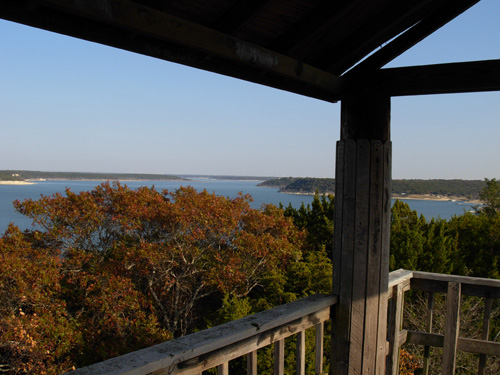
Belton Lake from the observation tower on
Flagpole Hill
When we checked into BLORA we asked about the nearest gate into
the main post, which was to our southwest. Park staff quickly informed us that we would have
to drive all the way around the post to the main gate and
register at the Visitor Control Center, a 34-mile drive.
Once we got there, however, the
process was much faster than we expected. We had to show our
drivers' licenses, military ID cards, vehicle registration and
proof of insurance. We got a temporary vehicle pass good for
the entire time we were at BLORA. Then we could enter any of the
six or seven gates onto the main post. The nearest gate to our
campground was about ten miles away. When we wanted to shop in
Killeen on the south side of the post the shortest route was to
drive through the post and not around it.
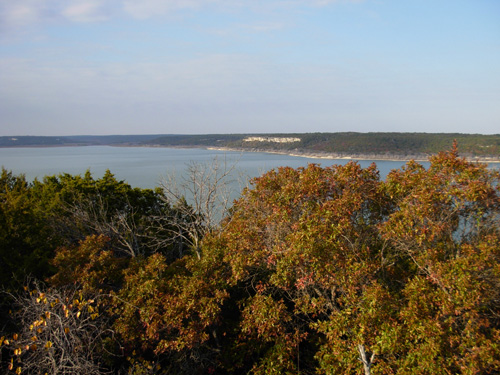
Another view of the lake from the
observation tower
I don't know the drill to get on post when a non-military ID
holder wants to visit Club Hood, the museums, or various public
events. I assume they have to go to the Visitor Control
Center for a temporary pass. To use the recreational area or
take the holiday lights tour at Belton Lake, visitors can just
show up at the BLORA gate and pay the entrance fee.
A BIT OF HISTORY
Remember those longhorn cattle I showed you in the
November 20 entry? They graze
the open range lands at Fort Hood. I learned
how that came about when I was researching some history for this
journal entry.
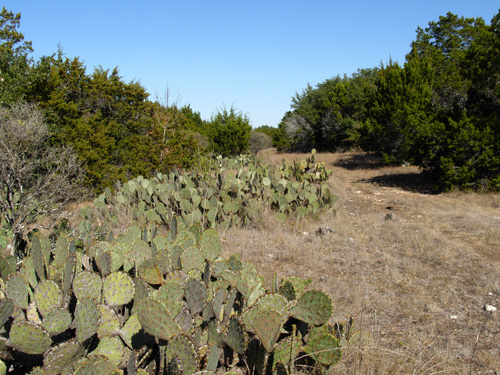
When running or cycling on the mountain
bike course, watch out for the cacti and cow pies.
During World War II the Army needed lots of room for tank
destroyer testing and training to combat the Germans. Central
Texas was chosen as the site for a new garrison because of its
abundance of space and rolling, semiarid terrain. It continues
to be a good place for the Army's multifaceted training and
testing of military units and individuals.
About half of the current land was initially acquired in 1941
and construction began on Camp Hood, named after Confederate
General John Bell Hood. About 300 families had to move from
their homes to make way for Camp Hood. The communities of Clear
Creek, Elijah, and Antelope ceased to exist. According to
Wikipedia, "To lessen the
pain of moving, the Army agreed to allow land to be used for
grazing for a nominal grazing fee. This grazing arrangement
still continues today."
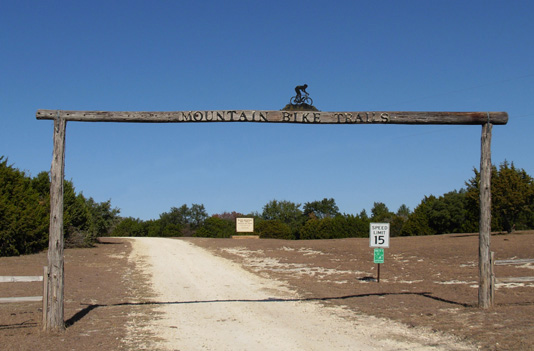
Hence, all the cattle that roam the wide open range land where
the soldiers test missiles and practice tactical maneuvers! We
drove through ten miles of that land each time we went on post
and had to be careful not to hit any cows. Unlike deer, cattle
take their sweet time to cross the road -- or just stand in the
middle of it. We also had to avoid a
lot of cow patties on the bike trails. We never did figure out
how they got past the fences and cattle guard to leave presents
in the large field behind our campground at BLORA . . .
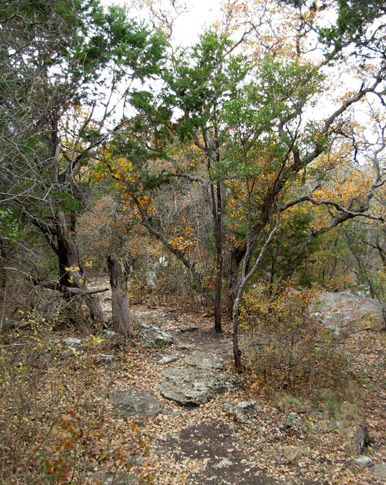
Along the Minefield Trail on the mountain
bike course
Oops. Got sidetracked.
Fort Hood played a major role in World War II -- and every
subsequent war since, up to and including Afghanistan and Iraq.
Troop population has fluctuated over the years, depending on
world conditions. Its land mass has doubled. Besides its obvious
peacekeeping mission, Fort Hood also plays major roles in
national/international disaster relief and training/mobilizing
the Reserve and National Guard to support Homeland Defense
efforts.
There is a lot of interesting historical information on the
official
Army web site (including this
history page and this
facts page), good ole
mostly-reliable
Wikipedia, and other sites you
can search on your own.
OUR ACTIVITIES ON POST
Every trip to a military installation with Jim increases my
scant knowledge of how the armed services are organized and
managed. I did not grow up in a military family, although my
brother was in the Navy for four years.

Part of the Nature in Lights holiday light
show at Belton Lake
Jim's father was in the Navy but he was out by the time Jim was
born so he didn't grow up in a military lifestyle, either.
However, Jim was in the Army from 1967-1970 and served in Viet
Nam for a year. Upon his return to the U.S. he was stationed at
Fort Hood the last 16 months of his active duty and lived on
post. After his discharge he served another 18 years in the
National Guard. That's how he earned his status of "retired military
member."
I've enjoyed learning more about military life since marrying
Jim. I've also enjoyed some of the perks that come with being
a "retired military spouse," such as the FamCamps we've used and
other facilities and activities on the posts and bases we've
visited. Because of its size, Fort Hood probably offers more to
its active troops and retirees than any other military
installation in the country. We found plenty to do on four or
five trips onto the main post and left some things to do during
future visits.
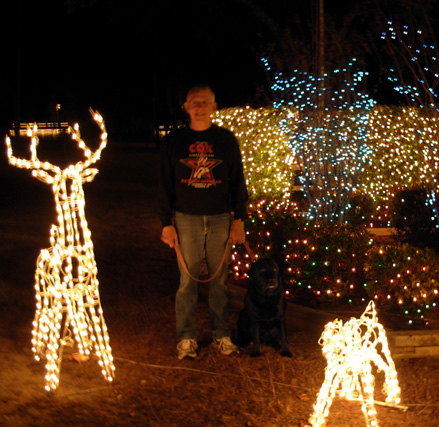
Jim and Cody posed in one of the displays.
Jim hasn't been to Fort Hood in thirty-eight years. He was
curious if he'd recognize any of the buildings he used and the
airfield where he trained.
On our first day in the area we got our vehicle pass and drove
around some of the main roads through the post. As you can
imagine, a lot has changed in almost four decades. The post has
experienced several growth spurts and efforts to modernize the
buildings and improve housing. Jim didn't recognize much, even
where he used to live. And the airfield was moved, too!
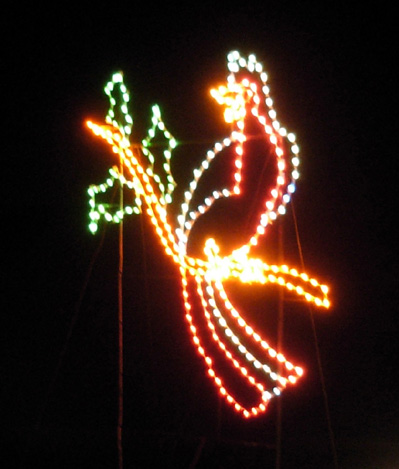
Partridge in a pear tree, part of the
Twelve Days of Christmas display
While at the Visitor Control Center we picked up a monthly
magazine called Hood Happenings and the weekly newspaper,
The Sentinel. Both were very helpful resources during our
visit. The magazine had a good map of the post, making
navigation quite easy. There were also articles about
the Nature in Lights display at BLORA, special meals at Club
Hood, and other activities.
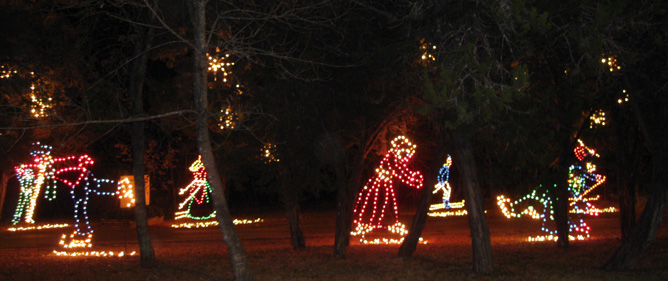
Part of the Nordic skier/skater display
Most of our activities on post were pretty mundane, like using
their laundromat several times (inexpensive, clean, never busy
when we were there) and going to the two PXs and one of the
commissaries. Sometimes we've found great deals on posts/bases,
sometimes not. For example, we purchased most of our food the
past week at Walmart and Sam's Club in Temple and Killeen
because their prices are better than the Fort Hood commissaries.
We
tolerated the hordes at both PXs on Friday and Saturday after
Thanksgiving, however, to get more than half off a Magellan GPS
navigation unit for the truck, a new set of cookware for the
camper, and a couple
of 4G flash drives for our computers. It was worth the waits in
line to save as much as we did and also avoid paying sales tax.
(Sales tax around here is a whopping 8+ cents but food isn't
taxed.) Other items like a portable propane grill and electric shaver
were a better deal in town, however.
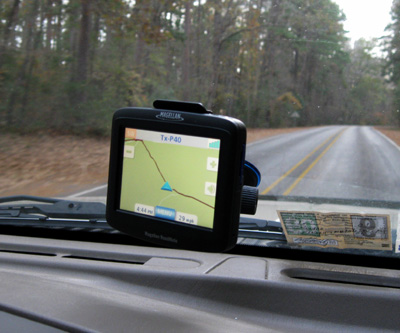
Jim's been having fun programming "Maggie," our name for the
female voice navigating us with the GPS unit. (Very clever,
aren't we? Probably six million other people call their Magellan
GPS "Maggie!") Jim has borrowed several other brands and
models of the trackers from friends so he could determine which
one he wanted. This one was quite reasonably priced at 55% off
retail and seems to have all the features we want. It
also seems more accurate than his older hand-held Garmin unit.
Ain't technology great?
"Maggie" has already sent us down one dead-end street, however.
Fortunately, we weren't pulling the camper at the time.
CHOWING DOWN
The Army has a large department or "Directorate" called
Morale, Welfare, and Recreation (MWR) that has its own
website
and publishes the Hood Happenings magazine to inform
soldiers, their families, and retirees about all sorts of
programs, activities, and events on post. MWR runs the Belton
Lake Outdoor Recreation Area, for example. The website has pages
devoted to sports and recreation, dining and lounges, concerts
and other events, and activities for children and youth.
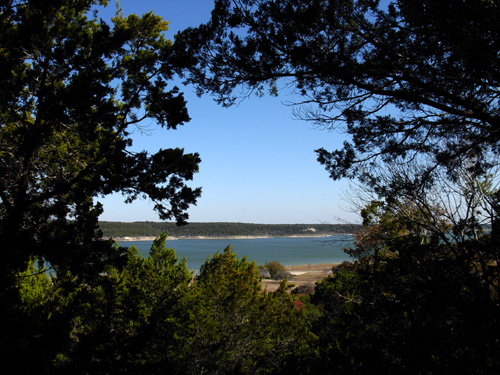
Nice view of Belton Lake from the Final Cut
Trail on the mountain
bike course
We quickly discovered that Club Hood, a nice dining and meeting
facility on post, offers several special meals. There is a lunch
buffet on weekdays, a fancy brunch on the first and third
Sundays (unfortunately, we were there on the fourth Sunday), and
a Tuesday night "Beef & Burgundy" buffet.
We never got to any of the daily lunch buffets but we tried out
the Beef & Burgundy buffet. Both the food and the value were good.
We had shrimp and other appetizers, hot slices of beef carved
to our order from a huge roast and served au jus, a baked potato, steamed
vegetables, rolls, desert, beverages, and wine (that's where the
"Burgundy" part comes from). We don't eat out very
often so this was a nice treat for us. It was also interesting
to see the mix of people who attended and what they wore, from
blue jeans to evening clothes, BDUs to Dress Blues. We were
somewhere in the middle on the formality scale
(who takes fancy clothes camping?).
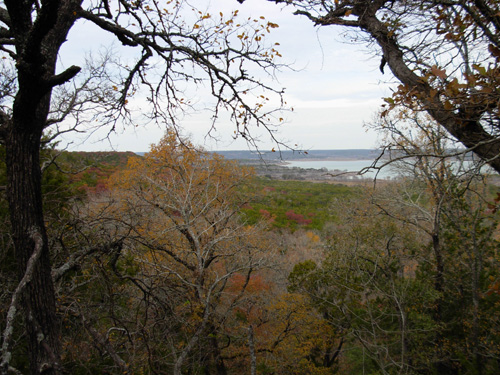
View of Belton Lake from the Minefield
Trail
When we knew we'd be at Fort Hood for Thanksgiving we hoped we'd
be able to find a nice place there or in one of the neighboring
cities for a nice dinner. It's hard enough to cook a traditional
Thanksgiving dinner for two when we're at home and have all the
equipment and space we need to "do it right." It's another
matter entirely to accomplish that feat in a tiny camper
kitchen! We didn't even consider it. So we were real
happy to read Hood Happenings our first day on post and discover
we could make Thanksgiving dinner reservations at the "second
seating" for their royal
spread. We even got a nice discount for being 55+ .
We arrived about 15 minutes before our 1:30 PM
reservation and expected to be first in line. Ha! We couldn't
believe the long line in front of us already. I bet they'd been
there before. After the last
folks from the first seating at 11:30 AM streamed out,
our line began to move and soon we were being shown to a
cloth-covered table with our name printed on a place card.
We got a good look at the buffet lines on the way to our table
-- appetizers, salads, entrees, deserts, beverages. It was quite a
spread in an enormous dining room. We were happy to be seated in
a corner of an adjacent dining room that was much cozier and had
minimal foot traffic.
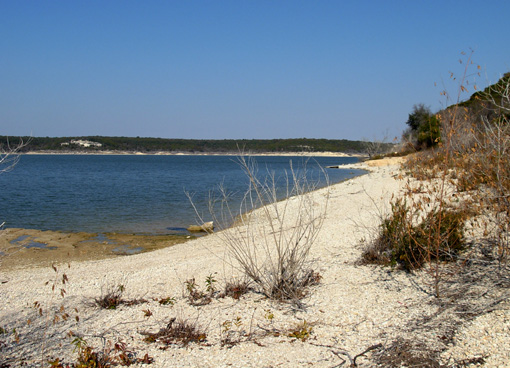
Scenic shore of Belton Lake near Cedar RV Park
The food was mostly excellent and another good value for the
price -- not as cheap as dining in one of the mess halls but
absolutely worth the money for the huge selection.
We could have satisfied our appetites at the two salad/appetizer
tables alone. There were six or seven kinds of expensive
cheeses, salmon, pates, and other toppings for crackers, other
appetizers, and quite a variety of fresh salad fixings. Entrees
included slices of roasted turkey breast, Virginia baked ham,
lemon-rosemary chicken, and tilapia. Traditional candied yams,
mashed potatoes, dressing, gravy, wild rice, honey glazed
carrots, green bean casserole, and cranberry sauce were offered,
as well as less traditional (in our families, at least) roasted
garlic red potatoes, corn on the cob, and macaroni and cheese (mac
& cheese??).
Various kinds of rolls, several beverages including rich egg nog,
and a plethora of desserts rounded out the meal.
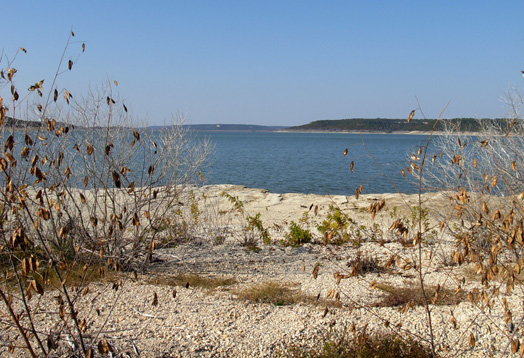
We thoroughly enjoyed our meal and had fun watching people
again. One fella had on an unofficial-but-very-popular Stetson
hat with his 1st Cavalry dress blues. Very classy. (When we got back to our
computers, Jim found a
website where I could read
about the history of the Cav Hat.)
Another distinguished-looking
middle-aged gentleman in a suit was greeting folks he knew at a
neighboring table. I figured he was probably a high-ranking
officer. As he passed our table, he looked very hard
at Jim, hesitated a bit, smiled and nodded, and wished us a
happy Thanksgiving. We joked after he was out of earshot that he
was probably wondering if Jim was a retired general or
something! He appeared to be trying very hard to remember if he
knew Jim and/or his rank.
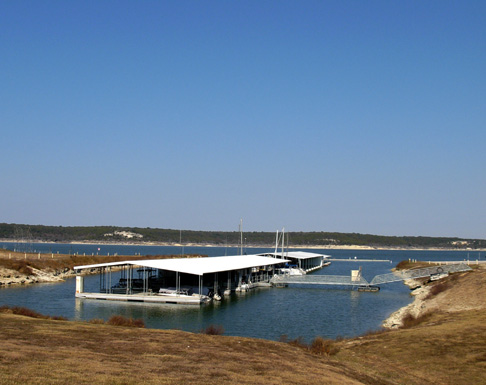
Marina at Belton Lake
On future trips we'd like to visit one or both of the military
museums, a couple of the fitness centers, maybe the theatre, and
take in a concert if one is scheduled while we're there. It's
always nice to save something for the next time.
MOVING ON
It's hard to believe that the first phase of our trip is already
over. In the morning we'll be heading east to Huntsville State
Park for a week. I'll have several entries about our training,
the great running/hiking/cycling trails in the park, and the Sunmart race. Stay tuned!
Cheers,
Sue
"Runtrails & Company" - Sue Norwood, Jim O'Neil, Cody, and
Tater (in spirit)
Previous
Next
© 2008 Sue Norwood and Jim O'Neil
